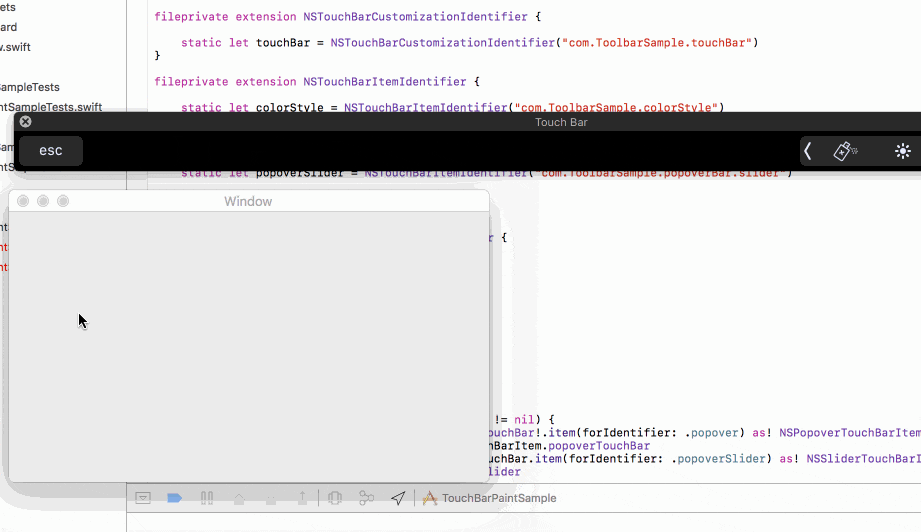環境
- MacOSX 10.12.3
TouchBarを使ったアプリを今更ながら試してみました。
Appleの提供しているサンプルであるToolbarSampleとNSTouchBar Catalogを読めば結構基本的な動きは使えるようになります。
問題はTouchBarをいかにうまく利用出来るかというところなんですが、そこは今後の課題です・・・。
サンプルはgithubに上げておきました。
TouchBarPaintSample
TouchBarの設定はWindowController上で実装します。
import Cocoa
fileprivate extension NSTouchBarCustomizationIdentifier {
static let touchBar = NSTouchBarCustomizationIdentifier("com.ToolbarSample.touchBar")
}
fileprivate extension NSTouchBarItemIdentifier {
static let colorStyle = NSTouchBarItemIdentifier("com.ToolbarSample.colorStyle")
static let colorStyleText = NSTouchBarItemIdentifier("com.ToolbarSample.colorStyleText")
static let colorStyleStroke = NSTouchBarItemIdentifier("com.ToolbarSample.colorStyleStroke")
static let popover = NSTouchBarItemIdentifier("com.ToolbarSample.TouchBarItem.popover")
static let popoverSlider = NSTouchBarItemIdentifier("com.ToolbarSample.popoverBar.slider")
}
class CustomeWindowController : NSWindowController {
let DefaultPenWidth : Int = 4
var currentPenWidth: Int = 0
override func windowDidLoad() {
super.windowDidLoad()
self.currentPenWidth = DefaultPenWidth
if #available(OSX 10.12.2, *) {
if ((NSClassFromString("NSTouchBar")) != nil) {
let penWidthTouchBarItem = self.touchBar!.item(forIdentifier: .popover) as! NSPopoverTouchBarItem
let sliderTouchBar = penWidthTouchBarItem.popoverTouchBar
let sliderTouchBarItem = sliderTouchBar.item(forIdentifier: .popoverSlider) as! NSSliderTouchBarItem
let slider = sliderTouchBarItem.slider
// Make the font size slider a bit narrowed, about 250 pixels.
let views = ["slider" : slider]
let theConstraints = NSLayoutConstraint.constraints(withVisualFormat: "H:[slider(250)]", options: NSLayoutFormatOptions(), metrics: nil, views:views)
NSLayoutConstraint.activate(theConstraints)
// Set the font size for the slider item to the same value as the stepper.
slider.integerValue = Int(DefaultPenWidth)
}
}
}
// MARK: - NSTouchBar
@available(OSX 10.12.2, *)
override func makeTouchBar() -> NSTouchBar? {
let touchBar = NSTouchBar()
touchBar.delegate = self
touchBar.customizationIdentifier = .touchBar
touchBar.defaultItemIdentifiers = [.colorStyle, .colorStyleText, .colorStyleStroke, .popover, .otherItemsProxy]
touchBar.customizationAllowedItemIdentifiers = [.colorStyle, .colorStyleText, .colorStyleStroke, .popover]
return touchBar
}
@available(OSX 10.12.2, *)
func changeColorWell(sender : NSColorPickerTouchBarItem) -> Void {
let color = NSColor(calibratedHue: sender.color.hueComponent
, saturation: sender.color.saturationComponent
, brightness: sender.color.brightnessComponent
, alpha: sender.color.alphaComponent)
let appDelegate: AppDelegate = NSApplication.shared().delegate as! AppDelegate
appDelegate.penColor = color
}
@available(OSX 10.12.2, *)
func changePenWidthBySlider(_ sender: NSSlider) -> Void {
let width = CGFloat(sender.floatValue)
let appDelegate: AppDelegate = NSApplication.shared().delegate as! AppDelegate
appDelegate.penWidth = Int(width)
}
}
extension CustomeWindowController: NSTouchBarDelegate {
@available(OSX 10.12.2, *)
func touchBar(_ touchBar: NSTouchBar, makeItemForIdentifier identifier: NSTouchBarItemIdentifier) -> NSTouchBarItem? {
switch identifier {
case NSTouchBarItemIdentifier.colorStyle:
let colorStylePicker = NSColorPickerTouchBarItem.colorPicker(withIdentifier: identifier)
colorStylePicker.customizationLabel = "colorStylePicker"
colorStylePicker.action = #selector(changeColorWell)
return colorStylePicker
case NSTouchBarItemIdentifier.colorStyleText:
let colorStylePicker = NSColorPickerTouchBarItem.textColorPicker(withIdentifier: identifier)
colorStylePicker.customizationLabel = "colorStyleText"
colorStylePicker.action = #selector(changeColorWell)
return colorStylePicker
case NSTouchBarItemIdentifier.colorStyleStroke:
let colorStylePicker = NSColorPickerTouchBarItem.strokeColorPicker(withIdentifier: identifier)
colorStylePicker.customizationLabel = "colorStyleStroke"
colorStylePicker.action = #selector(changeColorWell)
return colorStylePicker
case NSTouchBarItemIdentifier.popover:
let popoverItem = NSPopoverTouchBarItem(identifier: identifier)
popoverItem.customizationLabel = "Pen Width"
popoverItem.collapsedRepresentationLabel = "Pen Width"
let secondaryTouchBar = NSTouchBar()
secondaryTouchBar.delegate = self
secondaryTouchBar.defaultItemIdentifiers = [.popoverSlider];
// We can setup a different NSTouchBar instance for popoverTouchBar and pressAndHoldTouchBar property
// Here we just use the same instance.
//
popoverItem.pressAndHoldTouchBar = secondaryTouchBar
popoverItem.popoverTouchBar = secondaryTouchBar
return popoverItem
case NSTouchBarItemIdentifier.popoverSlider:
let sliderItem = NSSliderTouchBarItem(identifier: identifier)
sliderItem.label = "Width"
sliderItem.customizationLabel = "pen Width"
let slider = sliderItem.slider
slider.minValue = 2.0
slider.maxValue = 20.0
slider.target = self
slider.action = #selector(changePenWidthBySlider)
// Set the font size for the slider item to the same value as the stepper.
slider.integerValue = Int(DefaultPenWidth)
slider.bind(NSValueBinding, to: self, withKeyPath: "currentPenWidth", options: nil)
return sliderItem
default: return nil
}
}
}
TouchBarよりむしろ、ペイントの仕組みをiOSじゃなくてMacOSXで作る方に時間がかかったので、そのサンプル。
import Cocoa
class CustomeLine : NSObject {
var path : NSBezierPath!
override init() {
}
func move(point: NSPoint) {
path = NSBezierPath()
path.move(to: point)
}
func add(point: NSPoint) {
if(path == nil){
path = NSBezierPath()
path.move(to: point)
return
}
path.line(to: point)
}
func draw() {
if(path == nil){
return
}
let appDelegate: AppDelegate = NSApplication.shared().delegate as! AppDelegate
let color = appDelegate.penColor
let width = CGFloat(appDelegate.penWidth)
color.set()
path.lineWidth = width
path.stroke()
}
}
CustomeView.swift
import Cocoa
class CustomeView : NSView {
var line : CustomeLine!
var lastImage : NSImage!
@IBOutlet weak var imageView: NSImageView!
override func awakeFromNib() {
super.awakeFromNib()
line = CustomeLine()
configure()
}
func configure() {
let options:NSTrackingAreaOptions = [
.mouseEnteredAndExited,
.mouseMoved,
.cursorUpdate,
.activeAlways,
.enabledDuringMouseDrag
]
let trackingArea = NSTrackingArea(rect: bounds, options: options, owner: self, userInfo: nil)
addTrackingArea(trackingArea)
}
override func mouseDown(with event: NSEvent) {
let locationInView = self.convert(event.locationInWindow, from: nil)
line.move(point: locationInView)
drawImage()
}
override func mouseUp(with event: NSEvent) {
let locationInView = self.convert(event.locationInWindow, from: nil)
line.add(point: locationInView)
drawImage()
self.lastImage = imageView.image
}
override func mouseDragged(with event: NSEvent) {
let locationInView = self.convert(event.locationInWindow, from: nil)
line.add(point: locationInView)
drawImage()
}
override func mouseMoved(with event: NSEvent) {
// NSLog("aaa")
}
func drawImage() {
let size = self.frame.size
let image = NSImage(size: size)
let blub = NSBitmapImageRep(bitmapDataPlanes: nil,
pixelsWide: Int(size.width),
pixelsHigh: Int(size.height),
bitsPerSample: 8,
samplesPerPixel: 3,
hasAlpha: false,
isPlanar: false,
colorSpaceName: NSCalibratedRGBColorSpace,
bytesPerRow: 0, bitsPerPixel: 0)!
let ctx = NSGraphicsContext(bitmapImageRep: blub)
image.lockFocus()
NSGraphicsContext.saveGraphicsState()
lastImage?.draw(in: self.frame)
line.draw()
NSGraphicsContext.setCurrent(ctx)
NSGraphicsContext.restoreGraphicsState()
image.addRepresentation(blub)
image.unlockFocus()
imageView.image = image
}
}
参考
[iOSアプリ開発] タッチでお絵かきしてみる
ここの描画部分をMacOSXに書き換えたのが、今回のサンプル。Undoとかは未実装。
